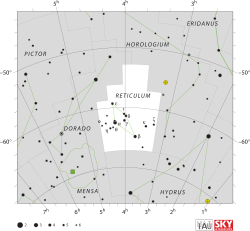Alpha Reticuli
| Observation data Epoch J2000.0 Equinox J2000.0 (ICRS) |
|
|---|---|
| Constellation | Reticulum |
| Right ascension | 04h 14m 25.48414s |
| Declination | −62° 28′ 25.8917″ |
| Apparent magnitude (V) | 3.315 |
| Characteristics | |
| Spectral type | G8 II-III |
| U−B color index | +0.63 |
| B−V color index | +0.922 |
| R−I color index | +0.659 |
| Astrometry | |
| Radial velocity (Rv) | +35.5 km/s |
| Proper motion (μ) |
RA: +41.97 mas/yr Dec.: +49.42 mas/yr |
| Parallax (π) | 20.18 ± 0.10mas |
| Distance | 161.6 ± 0.8 ly (49.6 ± 0.2 pc) |
| Absolute magnitude (MV) | −0.17 ± 0.05 |
| Details | |
| Mass | 3.11 ± 0.06 M☉ |
| Radius | 12.8 ± 0.6 R☉ |
| Luminosity | 240 L☉ |
| Surface gravity (log g) | 2.69 ± 0.04 cgs |
| Temperature | 5,196 K |
| Metallicity [Fe/H] | 0.07 dex |
| Rotational velocity (v sin i) | 5.7 km/s |
| Age | 0.33 ± 0.02 Gyr |
| Other designations | |
| Database references | |
| SIMBAD | data |
Alpha Reticuli (Alpha Ret, α Reticuli, α Ret) is the Bayer designation the brightest star in the southern circumpolar constellation of Reticulum, with an apparent visual magnitude of 3.3. This appears to be a solitary star located at a distance of 162 light-years from Earth. Although it is bright enough to be seen with the naked eye, the declination of this star means that it is best viewed from the southern hemisphere and is only readily visible below the tropic of cancer.
This star has more than three times the mass of the Sun and is about 330 million years old. The spectrum of this star matches a stellar classification of G8 II-III, with the luminosity class notation 'II-III' indicating it shows some traits of both a giant star and a bright giant. At this evolutionary stage, the atmosphere has expanded to almost thirteen times the radius of the Sun and the outer envelope has an effective temperature of 5,196 K. X-ray emission has been detected from this star, with an estimated luminosity of 3 × 1029 erg s−1.
Alpha Reticuli has a 12th-magnitude visual companion, CCDM J04144-6228B, at an angular separation of 48 arcseconds away along a position angle of 355°. Since the two stars share a common proper motion across the celestial sphere, it is possible that Alpha Reticuli, rather than being solitary, may instead be the primary component of a binary star system with an orbital period is at least 60,000 years.
...
Wikipedia

